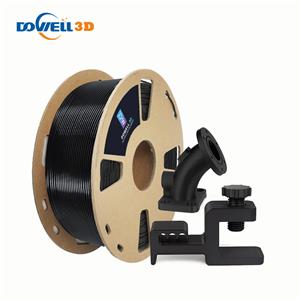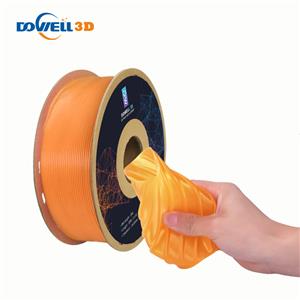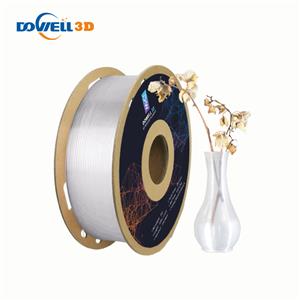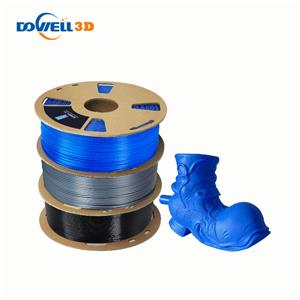Common 3D printing materials and their uses
Common-3d-printing-materials-and-their-uses
The material of 3D printing consumables can be said to be an important material basis for the development of 3D printing technology. To a certain extent, the development of materials also determines whether 3D printing can have wider applications. At present, 3D printing materials mainly include engineering plastics, photosensitive resins, rubber materials, metal materials, and ceramic materials. In addition, food materials such as colored gypsum materials, artificial bone meal, cell biological raw materials, and granulated sugar have also been obtained in the field of 3D printing. applied.
ABS material
ABS material has good thermal melting and impact strength, and is the preferred engineering plastic for fused deposition modeling 3D printing process. At present, ABS is mainly prefabricated into filaments and used after powdering. The application range covers almost all daily necessities, engineering supplies and parts. mechanical supplies. There are many colors of ABS materials, such as ivory white, white, black, dark gray, red, blue, rose red, etc., and are widely used in the fields of automobiles, home appliances, and consumer electronics. In recent years, ABS has not only gradually expanded its scope of application, but its performance has also been continuously improved. With the help of ABS' strong adhesion and strength, and through the modification of ABS, its application scope as a 3D printing material has been further expanded.
PA material
Although PA material has high strength, it also has certain flexibility. Therefore, 3D printing can be directly used to manufacture equipment parts. The PA carbon fiber composite plastic resin parts manufactured by 3D printing have high toughness and can be used for mechanical tools instead of metal tools. Solvay, a world-renowned expert in PA engineering plastics, 3D prints samples based on PA engineering plastics, which are used for engine peripheral parts, door handle kits, brake pedals, etc. Replacing traditional metal materials with PA materials finally solves the problem of lightweight vehicles.
PC material
PC (polycarbonate) material can be regarded as a real thermoplastic material, which has the characteristics of high strength, high temperature resistance, impact resistance, bending resistance, etc., and its strength is 60% higher than that of ABS material. Application of strong engineering products. The three major application fields of PC engineering plastics are glass assembly industry, automobile industry and electronics and electrical industry, followed by industrial machinery parts, CDs, packaging, computers and other office equipment, medical and health care, films, leisure and protective equipment, etc. PC can be used as door and window glass, and PC laminates are widely used in banks, embassies, detention centers and protective windows in public places, for aircraft canopies, lighting equipment, industrial safety baffles and bulletproof glass.
PPSF material
PPSF material is the material with the highest strength, the best heat resistance and the highest corrosion resistance among all thermoplastic materials. Widely used in aerospace, transportation and medical industries. Typically used as a final component. PPSF has the highest heat resistance, toughness and chemical resistance, and has the best performance among various rapid prototyping engineering plastics. Through the composite treatment of carbon fiber and graphite, PPSF material can exhibit extremely high strength and can be used in 3D Printing and manufacturing the load-bearing products has become the material of choice to replace metals and ceramics.
PEEK material
PEEK (polyether ether ketone) is a special engineering plastic with excellent properties such as high temperature resistance, self-lubricating, easy processing and high mechanical strength. It can be manufactured and processed into various mechanical parts, such as automotive gears, oil screens, gear shifting Starter disk; aircraft engine parts, automatic washing machine wheels, medical equipment parts, etc. PEEK has the advantages of excellent wear resistance, biocompatibility, chemical stability, and Young's modulus closest to human bone. It is an ideal artificial bone replacement material and is suitable for long-term implantation in the human body. The 3D printing technology based on the principle of fused deposition modeling is safe and convenient, does not require the use of lasers, and the post-processing is simple. The bionic artificial bone is manufactured by combining with PEEK material.
PLA material
PLA (Poly Lactic Acid) is polylactic acid, which may be one of the best raw materials in the 3D printing industry, with a variety of translucent colors and gloss. As an environmentally friendly plastic, PLA is biodegradable into active compost. It's derived from cornstarch and sugar cane, not fossil fuels. Tan.K.H of Nanyang Technological University, Singapore, etc., used degradable polymer materials to manufacture high-porosity PLA tissue engineering scaffolds in their research on the application of PLA to fabricate tissue engineering scaffolds. Through tissue analysis of the scaffold, it was found that it has growth ability. PLA is a new type of bio-based and biodegradable material. It has good biodegradability. After use, it can be completely degraded by microorganisms in nature under specific conditions, and finally produces carbon dioxide and water without polluting the environment. The environment is very favorable, and it is recognized as an environmentally friendly material.
PCL material
PCL (polycaprolactone) has good biodegradability, biocompatibility and non-toxicity, and is widely used as a medical biodegradable material and drug controlled release system, and can be used in tissue engineering as a drug sustained release system. PCL material is a kind of degradable polyester with a low melting point, only about 60°C. Like most biological materials, people often use it for special purposes such as drug delivery devices, sutures, etc. At the same time, PCL also has shape memory sex. In 3D printing, because of its low melting point, it does not require a high printing temperature, so as to achieve the purpose of energy saving, and can be used for low-temperature 3D printing pens. In the medical field, it can be used to print heart stents, etc.
PETG material
PETG material is a transparent plastic, an amorphous copolyester with good viscosity, transparency, color, chemical resistance, and stress whitening resistance. Can be quickly thermoformed or extrusion blow molded.




